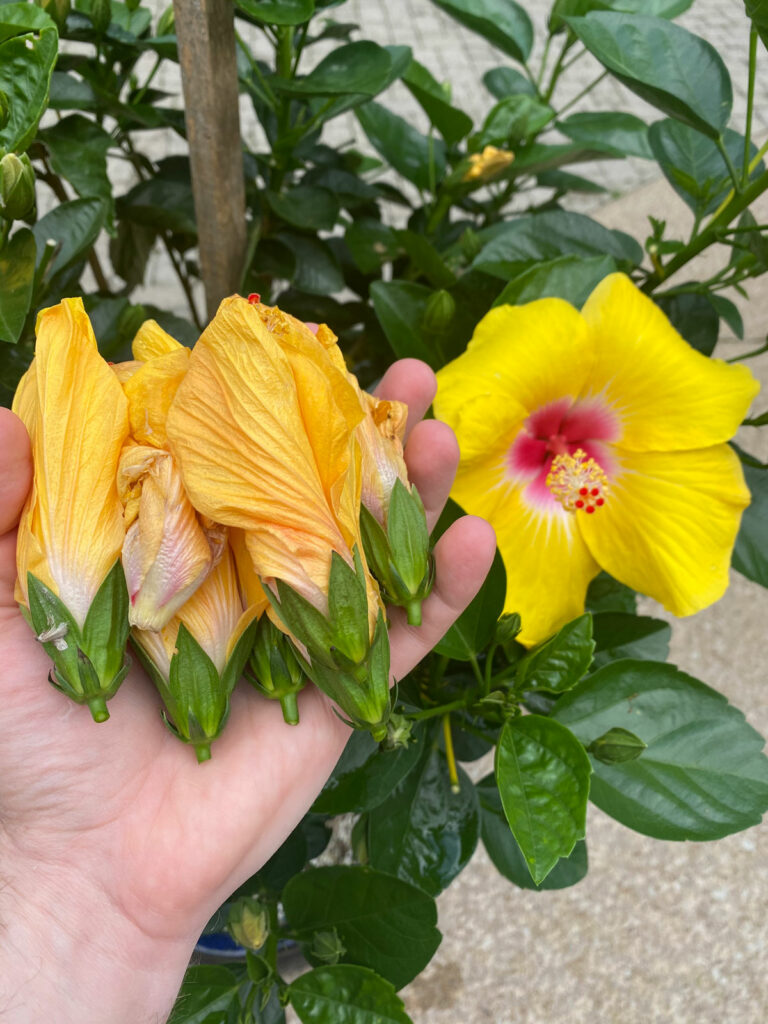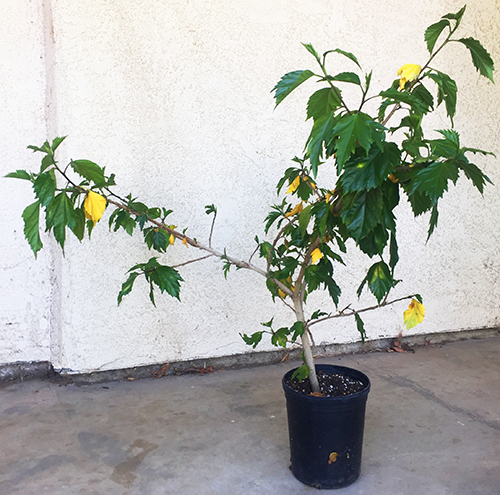To treat a stressed hibiscus, provide it with proper sunlight, water regularly, and maintain a consistent temperature. Additionally, gently prune the plant, avoid over-fertilizing, and use organic pest control methods if necessary.
Hibiscus plants are known for their vibrant flowers and lush foliage, but they can become stressed and unhealthy if not properly cared for. Stress can be caused by factors such as lack of sunlight, insufficient watering, extreme temperature fluctuations, pests, and improper maintenance.
We will discuss effective methods to treat a stressed hibiscus and restore its overall well-being. By following these simple steps, you can help your hibiscus plant regain its vitality and enjoy beautiful blooms once again.

Credit: www.ohiotropics.com
Identifying Common Symptoms Of Stress In Hibiscus Plants
Stressed hibiscus plants can exhibit various symptoms that indicate their distress. One common sign is wilting and drooping leaves, which occur due to insufficient water or excessive heat. Another symptom is yellowing or browning leaves, often caused by nutrient deficiencies or over-watering.
Stunted growth is another issue, pointing to unsuitable growing conditions or lack of proper care. If your hibiscus plant is not producing as many flowers as usual, it may be under stress too. To treat a stressed hibiscus, assess its environment and make necessary adjustments.
Ensure it receives adequate water, sunlight, and nutrients. Properly pruning to encourage healthy growth and removing any pests or diseases is also crucial. By providing the right conditions and care, you can help your hibiscus recover from stress and thrive once again.
Potential Causes Of Stress In Hibiscus
Stress in hibiscus plants can arise from various environmental factors. Inadequate watering practices, such as underwatering or overwatering, can cause stress. Nutrient deficiencies, particularly in essential minerals like nitrogen, phosphorus, and potassium, can also lead to hibiscus stress. Pests and diseases, such as aphids, spider mites, or fungal infections, can further exacerbate the plant’s stress levels.
To treat a stressed hibiscus, it is crucial to address these potential causes. Ensure proper watering practices by watering the plant deeply and allowing the soil to dry out slightly between waterings. Fertilize the hibiscus with a balanced fertilizer to replenish any nutrient deficiencies.
Regularly inspect the plant for pests or diseases and take appropriate measures, such as using organic insecticides or applying fungicides, if necessary. By addressing these factors and providing the necessary care, you can alleviate stress and promote the health of your hibiscus plant.
How to Treat a Stressed Hibiscus: Step by Step Guide
Adjusting Environmental Conditions
Adjusting environmental conditions is crucial when it comes to treating a stressed hibiscus. Providing adequate sunlight is essential for its growth and recovery. Maintaining optimal temperature and humidity levels is equally important to ensure the plant’s health. The hibiscus should be placed in an area protected from harsh winds, as this can cause further stress and damage.
By creating a suitable environment, the hibiscus will have the best chance of recovering from its stressed state. Regularly monitoring and adjusting these conditions will greatly benefit the plant and promote its overall well-being. Remember to assess the needs of the hibiscus and make any necessary changes to ensure its optimal growth and happiness.
Proper Watering Techniques
Proper watering techniques are crucial when it comes to treating a stressed hibiscus. Determining the right amount of water is essential for its well-being. Ensure that you provide the hibiscus with the correct amount of water as overwatering or underwatering can be detrimental.
Having proper drainage is also important as it prevents waterlogged soil and root rot. Make sure the water can flow freely through the pot or garden bed. Establishing a consistent watering routine is beneficial to maintain the hibiscus’ health. Regularly monitor the moisture level in the soil and water accordingly.
By following these guidelines, you can effectively treat a stressed hibiscus and promote its overall growth and well-being.
Nutrient Management For Hibiscus
Hibiscus plants can experience stress due to various factors, such as improper nutrient management. To ensure their health and vitality, it’s important to understand the essential nutrients they require. Proper fertilizer application guidelines can help provide these necessary nutrients to a stressed hibiscus.
When choosing between organic and synthetic fertilizers, it’s essential to consider their pros and cons. Organic fertilizers can be beneficial as they improve soil health and promote sustainability. On the other hand, synthetic fertilizers can provide a quicker nutrient boost.
Ultimately, the choice between the two depends on personal preferences and the specific needs of the hibiscus. By following nutrient management practices and utilizing the right fertilizers, stressed hibiscus can be effectively treated and their overall well-being improved.
Addressing Pests And Diseases
Stressed hibiscus plants can be effectively treated by addressing common pest infestations and implementing natural pest control methods. Recognizing signs of pest damage such as yellowing leaves, stunted growth, and distorted flowers is crucial. To combat pests naturally, consider introducing beneficial insects like ladybugs or using organic pest control sprays.
Additionally, implementing good cultural practices such as removing weeds and regularly inspecting the plants for signs of infestation can help keep pests at bay. Moreover, using intercropping techniques and planting companion plants can deter pests and create a healthy growing environment for your hibiscus.
In addition to pest control, effective disease management strategies are essential for a stressed hibiscus. Regularly inspecting the plants for signs of diseases like leaf spot or powdery mildew and promptly treating any infections with organic fungicides can prevent further damage.
By addressing pests and diseases promptly and naturally, you can help your stressed hibiscus thrive.
Regular Maintenance Practices
Regular maintenance practices are essential for treating a stressed hibiscus. Pruning and shaping the plants help maintain their health. Removing weeds and debris ensures a clean environment for the hibiscus to thrive. Adding mulch around the plants aids in moisture retention, promoting their overall well-being.
By following these practices, you can improve the condition of your stressed hibiscus and help them regain their vibrancy. Remember, regular care is crucial for their longevity and beauty.
Monitoring For Signs Of Stress
Stressed Hibiscus plants can benefit from regular inspections of their leaves and flowers for signs of distress. By closely monitoring their foliage and blooms, gardeners can detect early symptoms of stress, such as discoloration or wilting. It is also crucial to keep track of any environmental changes that may be affecting the plant’s well-being.
Factors like temperature fluctuations, excessive sunlight, or inadequate watering can cause stress in Hibiscus. If the plant shows persistent signs of distress despite proper care, seeking professional help from a knowledgeable horticulturist or gardening expert may be necessary. By taking proactive measures and being attentive to their Hibiscus’s needs, plant owners can effectively treat and alleviate stress, helping their vibrant blooms to flourish once again.
Creating A Stress-Free Environment
To treat a stressed hibiscus, it’s crucial to create a stress-free environment. Promote good air circulation by giving the plant enough space. Minimize exposure to chemicals by opting for organic fertilizers and pesticides. Provide proper support and trellising options to help the hibiscus grow strong.
Ensure that the plant receives the right amount of sunlight and water, as both are essential for its well-being. Regularly remove any dead or damaged leaves to maintain the plant’s health. Remember to observe the hibiscus closely to address any signs of distress promptly.
By following these guidelines, you can restore your stressed hibiscus to its full glory.
Frequently Asked Questions On How To Treat A Stressed Hibiscus
How Do You Fix Wilted Hibiscus?
To fix wilted hibiscus, ensure it receives enough water, place it in indirect sunlight, and remove any damaged leaves.
Why Is My Hibiscus Stressed?
Possible answer: Hibiscus plants can get stressed due to factors like inadequate watering, improper sunlight, pests, or diseases.
Should I Use Miracle Grow On My Hibiscus?
Miracle Grow is suitable for hibiscus as it provides essential nutrients for their growth.
What Does Epsom Salt Do For Hibiscus Plants?
Epsom salt boosts hibiscus growth, enhances nutrient absorption, and prevents yellowing of leaves.
Conclusion
Caring for a stressed hibiscus requires a combination of patience and proper techniques. By diagnosing the underlying cause of stress, whether it be environmental factors, pests, or diseases, you can effectively treat and restore the health of your hibiscus. Providing the right amount of sunlight, water, and nutrients is essential, as is ensuring proper drainage and maintaining a consistent watering schedule.
Additionally, regularly inspecting your plant for signs of pests or diseases and taking immediate action can prevent further stress and damage. Remember to prune regularly to encourage new growth and remove any dead or damaged branches. With a little attention and care, your hibiscus will bounce back to its former vibrant and healthy state, providing you with beautiful blooms for seasons to come.

